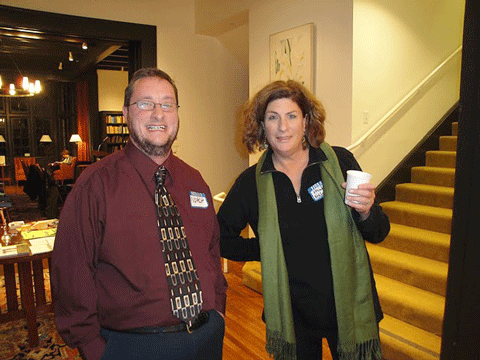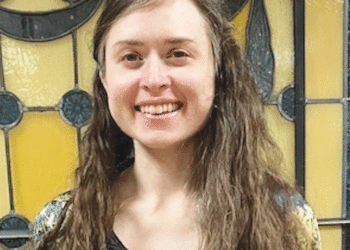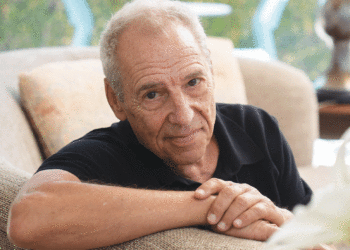Transgender Jews, those who do not identify with the gender into which they were born, create resources for negotiating the community’s ‘gender binary’
By SUE FISHKOFF
BERKELEY, Calif. (JTA) — Noach Dzmura is a roly-poly man with a light brown beard, dancing eyes and a contagious laugh.
He has a master’s degree in Jewish studies, publishes widely on Jewish topics and is the communications director at his synagogue. In 2006 he received an award from the San Francisco Jewish federation that funded a year’s study in Israel.
He also was born a female.
 Transgender activist Noach Dzmura (left) celebrates his book launch on Dec. 2, 2010, in Berkeley, Calif., with Heidi Feldman, of the Richard S. Dinner Center for Jewish Studies. (Photo: Courtesy of Noach Dzmura)
Transgender activist Noach Dzmura (left) celebrates his book launch on Dec. 2, 2010, in Berkeley, Calif., with Heidi Feldman, of the Richard S. Dinner Center for Jewish Studies. (Photo: Courtesy of Noach Dzmura)
Dzmura, 48, is one of a growing number of transgender Jews who are open about their status, taking leadership roles in the synagogue and trying to carve out a place in the Jewish community for those who fall outside the standard definitions of male and female.
It’s not easy, he acknowledges.
“Transgender people have tended historically to ‘go stealth’ (blend in as a non-transgender person) or opt out of Jewish communal life altogether,” he wrote in Balancing on the Mechitza, a collection of essays about transgender Jews in the Jewish community that Dzmura edited in 2009. It won this year’s Lambda Literary Prize for Non-Fiction.
Transgender individuals do not identify with the gender into which they were born. Some undergo sex reassignment surgery so their external genitalia correspond to their inner sense of who they are, but most do not. Some take hormones to encourage secondary sexual characteristics. Others simply live as the opposite sex, changing their dress, hairstyle and other outward details. Still others do not identify as male or female.
There are no hard statistics on the number of transgender Jews.
Rabbi Reuben Zellman, 32, who transitioned from female to male before his acceptance to Reform rabbinical school and is now the assistant rabbi at Berkeley’s Congregation Beth El, says hundreds of transgender Jews from all over the country have contacted him for advice.
Zellman says he has worked with more than 150 who wanted to change their Hebrew names to reflect a different gender status.
“I’ve heard people combine ben and bat to get ban,” he said, referring to the custom of calling Jews the “son of” or “daughter of” their parents. Other variations are mibet, meaning “from the house of,” or mimishpachat, meaning “from the family of.”
Zellman changed his Hebrew name from Hannah Yoninah to the masculine Hananya Yona when he began living as a man 22 years ago. But he is still “ben Herschel v’Gitel.” There are no set rules, he says; the business of living openly as a transgender Jew is still too new.
The San Francisco area attracts many transgender Jews, but here, too, the numbers are unknown. Dzmura, who runs a prayer group for about a dozen transgender Jews in the East Bay, says San Francisco’s Congregation Sha’ar Zahav, a GLBT-friendly shul, usually gets 40 to 100 people at its transgender Shabbat programs.
Jewish tradition does not look kindly upon those who cross accepted gender boundaries.
Although the Mishna and the Talmud discuss the legal status of individuals who are not fully male or female — hermaphrodites, eunuchs and others with questionable gender identities — the observant community does not accept transgenderism as distinguished from intersex individuals, those born with indistinct sexual status.
In September 2008, when the former Jay Ladin returned to his post as an English professor at the Orthodox-affiliated Yeshiva University’s Stern College for Women after transitioning to a woman, named Joy Ladin, she was castigated by the university administration for what was seen as her inappropriate choice. Ladin disputed that it was a choice, saying it was something she had to do.
Rabbi Avi Shafran, director of public affairs for the haredi Orthodox Agudath Israel of America, said changing one’s gender through surgery or other medical intervention is prohibited according to Jewish law.
“Halachically and theologically, from the perspective of the Jewish religious tradition, a person’s sexual identity is dependent on the sex he or she is born as, assuming that the person’s genitals are unambiguous,” Shafran said.
The Conservative movement also regards genitals as the final determinant. Although the movement has not said whether sex reassignment surgery is allowed, a 2003 responsum by its committee on law and standards holds that individuals who complete surgery and whose new gender is accepted by state authorities should be so recognized by Jewish law.
There are a variety of Reform responsa on the topic.
Dzmura, Zellman and their colleagues in the trans-Jewish activist community want to encourage the next generation of transgender Jews to join the Jewish community instead of avoiding it.
The goals they have set range from the mundane to issues of ritual and worship. They want to get Jewish institutions to provide non-gendered bathrooms, which a few now do. They also want to be able to determine for themselves which side of the mechitzah to choose in an Orthodox shul, and how to marry or convert in more liberal congregations.
“Liberal Judaism says come on in, but when it comes to changing our schools, how we bless our children, our rites of passage to adulthood, how we bury people, we really stick to a gender binary,” Dzmura said.
Rituals that expose the entire body, such as mikvah, the ritual bath, and tahara, the preparation of a body for burial, are the biggest challenges.
Dzmura, who converted to Judaism several years ago after changing his gender, remembers being terrified that during his conversion ceremony he’d be thrown out of the Orthodox mikvah if anyone from that congregation saw his naked body and realized he was missing a major part of being male.
Then there’s the issue of how synagogues should handle transgender burials. Tahara committees, which wash and prepare a Jewish body for burial, are single-sex, matching the gender of the deceased. The burial clothing is slightly different for men and women, as are the way the knots on that clothing are tied. These may seem like minor details, Dzmura says, but kavod ha’met, or respect for the dead, is a central Jewish value.
In mid-June, Dzmura was invited to lead a workshop on transgender burial at the annual convention of Kavod v’Nichum, the national organization for Jewish funerals.
Tahara committees are confronting the issue more often, he says, and there are no guidelines to help them.
“The only trans-Jew I know who died had a memorial service, not a burial,” he told JTA. “I am certain that will change.”
As more transgender Jews come forward looking for inclusion in Jewish life, there are a growing number of trans-friendly Jewish resource and advocacy organizations nationwide. At least two are in the San Francisco area:JewishTraditions.org, run by Dzmura, and TransTorah.org, run by a collective of local rabbis and scholars including Zellman.
These resources can be accessed anonymously, which is particularly important for the more observant users, they say.
“Many trans people are not ‘out,’ especially those living in Orthodox or Hasidic communities where no one knows they’re transgender,” said Zellman.
“I work with trans people who have suffered tremendous exclusion from Jewish life,” he said. “Sometimes people get overwhelmed or intimated by the idea of expanding Jewish rituals. But it’s really not that hard.”
***









 Transgender activist Noach Dzmura (left) celebrates his book launch on Dec. 2, 2010, in Berkeley, Calif., with Heidi Feldman, of the Richard S. Dinner Center for Jewish Studies. (Photo: Courtesy of Noach Dzmura)
Transgender activist Noach Dzmura (left) celebrates his book launch on Dec. 2, 2010, in Berkeley, Calif., with Heidi Feldman, of the Richard S. Dinner Center for Jewish Studies. (Photo: Courtesy of Noach Dzmura)








